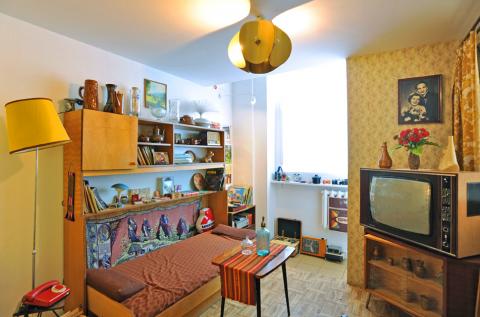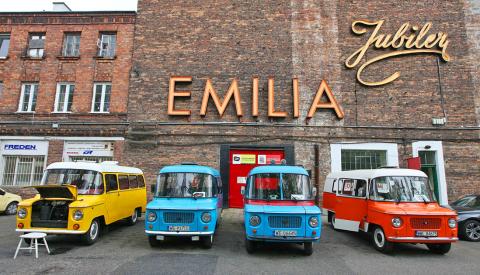There is no love lost in Poland for the bygone communist system, but those who think they have missed something unusual still have a chance to experience the austerity and subdued atmosphere of life in those times.
A life-under-communism museum in Warsaw offers tours of communist-era architecture, a look at a typical small apartment, a taste of cherry vodka and a ride in a militia van. Foreign tourists come here out of curiosity, Polish schoolchildren come to learn about those not-so-distant times that their parents grew up in, and parents and grandparents come out of nostalgia for their youth.
The museum, called The Charm of PRL (the People’s Republic of Poland), offers “Warsaw Experience” guided tours, in English and in other languages.

Photo: AP/ Alik Keplicz
Arranged in an old, bleak warehouse in a backstreet in Warsaw’s gritty Praga district, the tour offers a glimpse of more than four decades of life behind the Iron Curtain, under an oppressive system that was directed from Moscow. After communism was imposed on Poland following World War II, the country experienced persecution, deprivation and bans, often bordering on the absurd. The Poles, led by the massive Solidarity freedom movement, voted the system out in 1989 elections.
Inside the museum, visitors see a typical, modest one-bedroom apartment with simple, Polish or East Bloc-made house appliances, a typical office of a local party secretary with the communist leaders’ portraits and a hotline phone. In another spot, bust figures of Lenin and Marx, and an old radio serve as reminders that the communists were jamming Radio Free Europe and Voice of America, which the Poles secretly tuned into for true news.
VODKA OUT OF TRAGEDY

Photo: AP/ Czarek Sokolowsk
“We were there (under communism) for 45 years,” the museum’s driver-guide Mariusz Nurkiewicz said in English. “For example, my parents, they were young, they fall in love, I was born...So this is that sentimental feel to youth, to the past, more than to communism, to system. Nothing was too good about the system, but about the life, we were still trying to be happy.”
For a moment of respite, the visitors are invited to a bar to sample simple biscuits or wafers, enhanced by a toast of cherry vodka. Nearby stands a phone booth, with no phone inside, just as it sometimes was in communist times.
Nathan Hanson, a tourist from Dubuque, Iowa, said he has “always regretted not seeing anything Soviet before the Soviet Union fell. And I know remnants of that are quickly disappearing and so I booked the communism tour today to see what I could, to see what’s left.”
His conclusion from the tour was that the society in Poland is “changing very quickly.”
“It’s just fascinating to look back in time,” Hanson said. “It’s a big part of my generation with the conflict with the US and the Soviet Union, so it’s really neat to just get a peek of what it looked like.”
The visitors can also take a ride in a no-comfort Polish-made van used by the militia in the 60s and 70s to transport criminal and political detainees. For some US$42 per person, an English-speaking driver-guide will take them to see typical architecture of the time, including Poland’s tallest building, the Palace of Culture and Science, a 1955 gift from Soviet leader Joseph Stalin. It survived a cathartic push to have it torn down just after the ouster of communism, and celebrates its 60th birthday this year.
“We would see some of the architecture of that time which is called socialist realism (and) admire the figures of the working class, because all that system was built, was created, for the happiness of the working class,” Nurkiewicz said.
He jokingly said that he tries to get tourists join the Communist party.
“No, I’m just kidding of course. We are happy here in Poland (that) the communism is over.”

May 26 to June 1 When the Qing Dynasty first took control over many parts of Taiwan in 1684, it roughly continued the Kingdom of Tungning’s administrative borders (see below), setting up one prefecture and three counties. The actual area of control covered today’s Chiayi, Tainan and Kaohsiung. The administrative center was in Taiwan Prefecture, in today’s Tainan. But as Han settlement expanded and due to rebellions and other international incidents, the administrative units became more complex. By the time Taiwan became a province of the Qing in 1887, there were three prefectures, eleven counties, three subprefectures and one directly-administered prefecture, with

It’s an enormous dome of colorful glass, something between the Sistine Chapel and a Marc Chagall fresco. And yet, it’s just a subway station. Formosa Boulevard is the heart of Kaohsiung’s mass transit system. In metro terms, it’s modest: the only transfer station in a network with just two lines. But it’s a landmark nonetheless: a civic space that serves as much more than a point of transit. On a hot Sunday, the corridors and vast halls are filled with a market selling everything from second-hand clothes to toys and house decorations. It’s just one of the many events the station hosts,

Among Thailand’s Chinese Nationalist Party (KMT) villages, a certain rivalry exists between Arunothai, the largest of these villages, and Mae Salong, which is currently the most prosperous. Historically, the rivalry stems from a split in KMT military factions in the early 1960s, which divided command and opium territories after Chiang Kai-shek (蔣介石) cut off open support in 1961 due to international pressure (see part two, “The KMT opium lords of the Golden Triangle,” on May 20). But today this rivalry manifests as a different kind of split, with Arunothai leading a pro-China faction and Mae Salong staunchly aligned to Taiwan.

Two moves show Taichung Mayor Lu Shiow-yen (盧秀燕) is gunning for Chinese Nationalist Party (KMT) party chair and the 2028 presidential election. Technically, these are not yet “officially” official, but by the rules of Taiwan politics, she is now on the dance floor. Earlier this month Lu confirmed in an interview in Japan’s Nikkei that she was considering running for KMT chair. This is not new news, but according to reports from her camp she previously was still considering the case for and against running. By choosing a respected, international news outlet, she declared it to the world. While the outside world